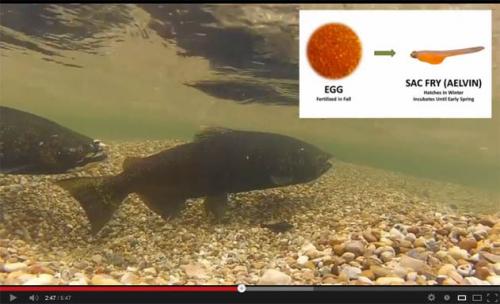Great Lakes salmon are the focus of new video series
Underwater footage of wild-spawned salmon in Michigan streams show the challenges faced by young fish. Participants in MDNR’s Salmon in the Classroom program can use this series as a refresher on the salmon’s life cycle and Great Lakes ecology.
April is an exciting time of year for salmon and trout anglers. Big lake trolling and pier fishing starts off in the southern end of Lake Michigan and the steelhead run is in in full swing in west Michigan streams. Another story unfolds in shoreline eddies, where young wild-spawned Chinook salmon feed on stream insects and put on weight for their journey to Lake Michigan.
The modern Great Lakes salmon fishery began with stocking programs in the late 1960s. At that time, salmon were unable to spawn successfully due to poor water quality, degraded stream habitats, and dams that blocked fish passage or altered river flow. Although salmon are not native to the upper Great Lakes, the Chinook salmon, in particular, has been able to adapt and is now spawning in streams where conditions have improved.
Although wild-spawned fish now account for over half of the Chinook salmon in Lake Michigan, stocking still plays a role in maintaining the Great Lakes fishery. State-run hatcheries around the basin contribute most of the salmon stocked each year, but volunteers with the Michigan Steelhead and 
Teachers and students from 180 classrooms around the state are participating in the Michigan Department of Natural Resources’ Salmon in the Classroom program, raising Chinook salmon. The program gives students the powerful experience of raising fish from egg to stocking size, then releasing young salmon into local streams in May.
A new video series from Michigan Sea Grant and articles from Michigan State University Extension will explore the history and ecology of the Great Lakes as it relates to the experiences of people who raise, watch, and fish for Chinook salmon. The first video – Salmon in the Great Lakes: Part 1, Early Life History – deals with the early life history stages of wild and captive salmon and is now available on the Michigan Sea Grant YouTube channel.



 Print
Print Email
Email




